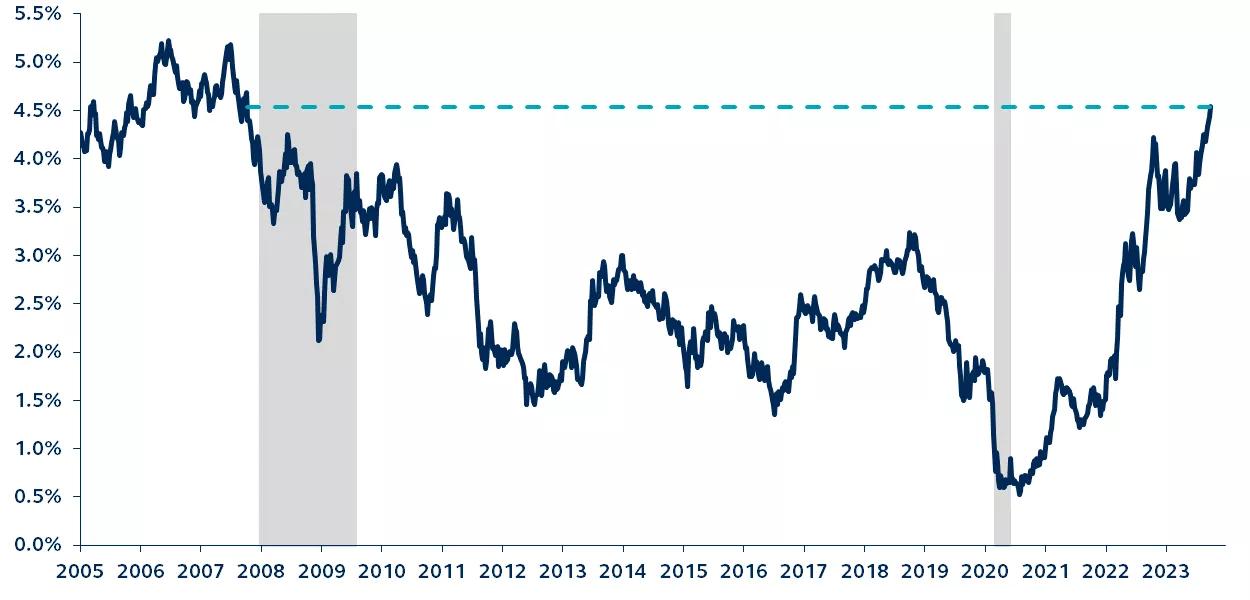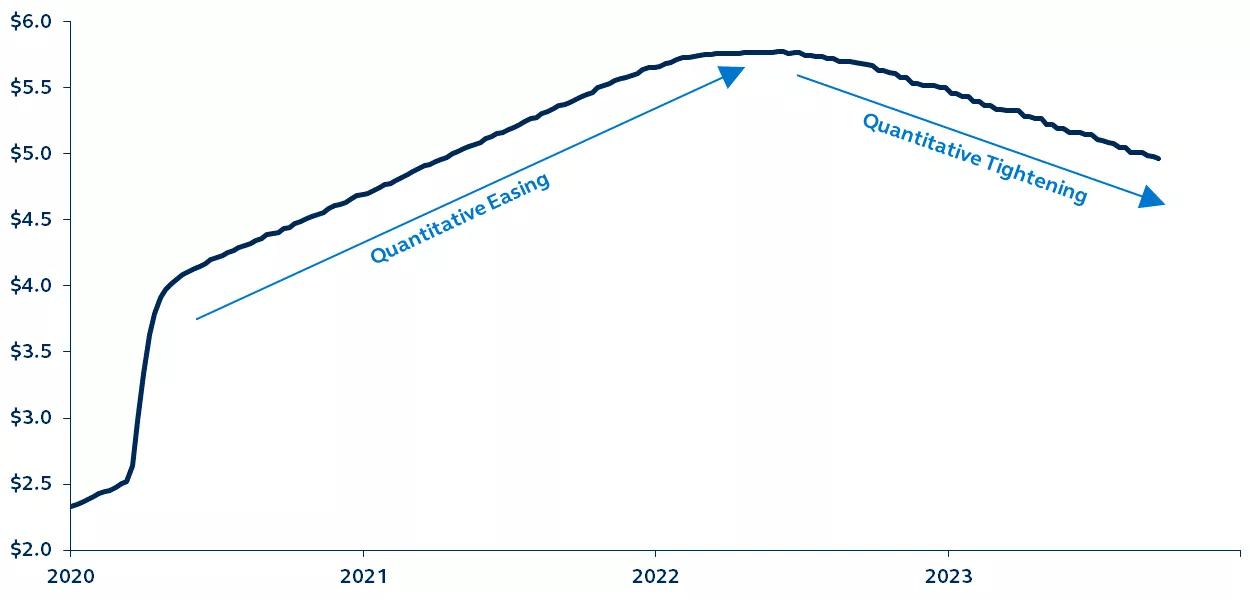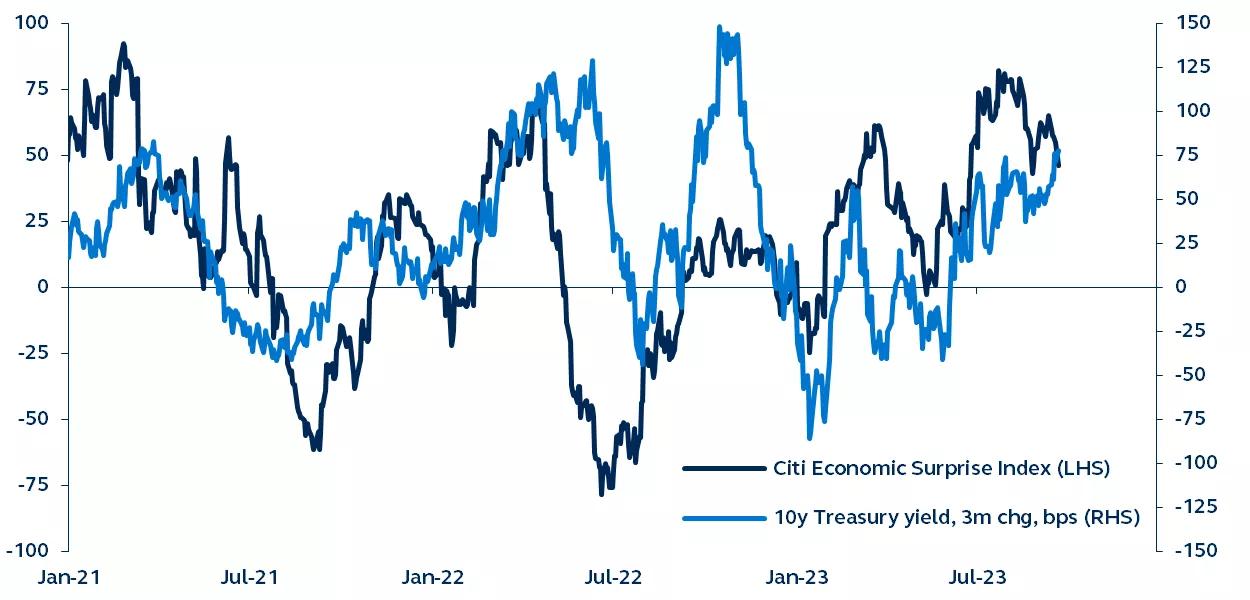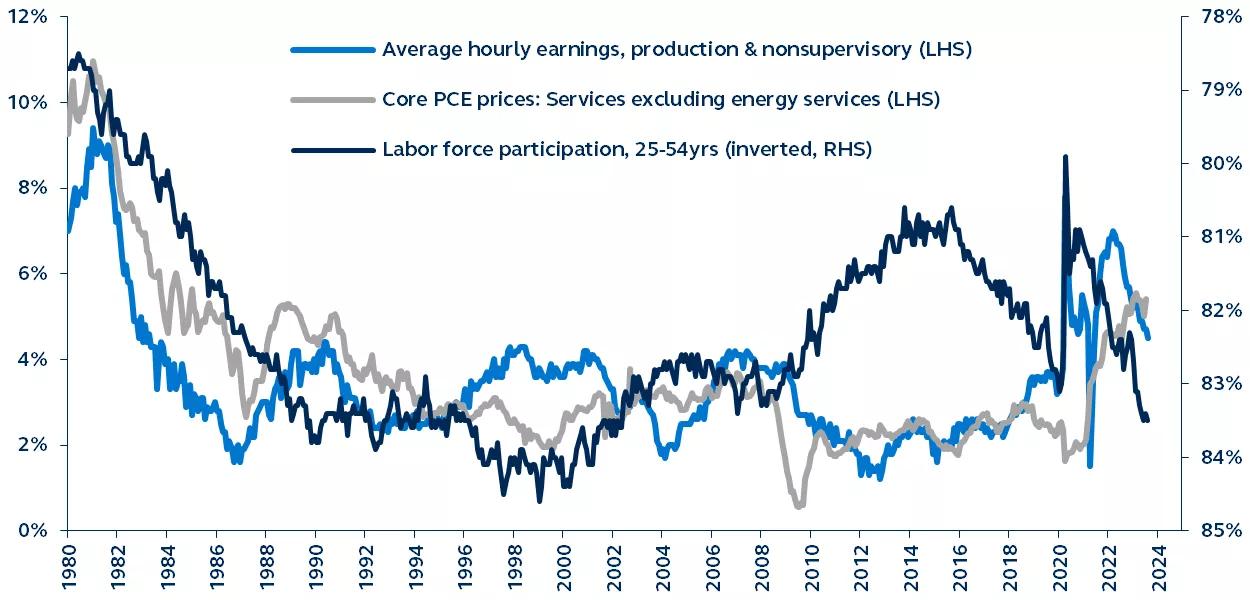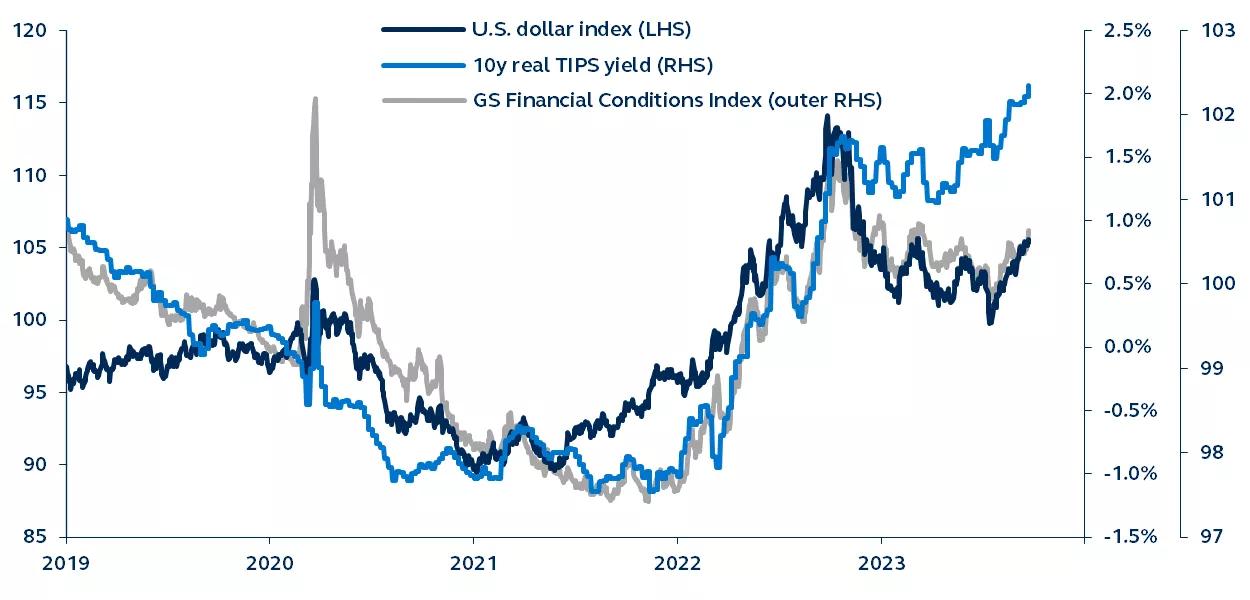
From Garrett Roche, CFA, FRM, Global Market Strategist at Principal Asset Management
The recent and sudden rise of U.S. Treasury yields has pushed long-term interest rates above the highs seen in October 2022 and even those observed before the Global Financial Crisis (GFC) in late 2007. This swift and significant increase in yields has intensified market volatility and eroded the value of bonds. With so much focus on the Federal Reserve’s (Fed) “higher for longer” rates path, it has become exceedingly important for investors to understand the drivers of higher bond yields, enabling them to assess whether today presents a bond-buying opportunity or if bond yields will be pushed even higher.
Deficits, issuance, downgrade

For nearly 60 years, the U.S. government’s budget deficit and the unemployment rate have been reasonably good indicators of each other; higher unemployment meant larger deficits as the government intervened to help right-size the economy. The most recent economic slowdown followed a similar path—massive expansionary fiscal policy in the wake of COVID-19—but this time, as the employment recovered, the budget deficit has not followed suit.
U.S. government budget deficit and U.S. unemployment rate
1968–present
Source: Bureau of Labor Statistics, US Treasury, Bloomberg, Principal Asset Management. Data as of August 31, 2023.
Absent higher taxes, the Federal government requires financing through greater Treasury issuance, and projected high deficits that require greater debt issuance, all else equal, place upward pressure on Treasury yields. The current deficit, as well as projections of colossal future deficits, has raised bond investor concerns about an abundance of forthcoming Treasury supply. In fact, in early August, the U.S. Treasury announced higher-than-expected debt supply and has scheduled increasing amounts of issuance using longer-dated maturities – an influential technical factor that is currently placing upward pressure on longer-dated Treasury yields.
Also read: U.S. 10-Year Bond Yield is expected to Hit 5.5%
U.S. 10y Treasury Yield
Recessions are shaded, weekly, 2005–present
Source: Federal Reserve, Bloomberg, Principal Asset Management. Data as of September 22, 2023.
Another consequence of ever-higher fiscal deficits putting pressure on yields is the assessment of bond rating agencies. On August 1, Fitch Ratings downgraded U.S. Treasury debt from its highest rating of AAA to one increment lower, AA+, reflecting the expected high and growing general government debt burdens. Rationally, the structural and potentially unsustainable character of U.S. public debt requires higher yields to appeal to investors.
In addition to the challenges posed by Treasury bond issuance, the corporate and mortgage bond sectors (MBS) have contributed to the mounting pressures on the market. For corporates, the end of summer often brings about higher bond issuance, and this year’s issuance once again proved substantial. On the MBS front, the resolution of bank failures earlier this year led to transferred mortgages being securitized and offered to bond investors. These combined factors have further deepened the strain on an already saturated bond market.
This year, persistent fiscal deficits requiring Treasury issuance, corporate bond issuance, and the sudden increase in mortgage issuance hit bond markets within a short timeframe. The non-Treasury issuance, though temporary, has created competition for Treasury securities, resulting in higher yields being necessary to attract investor demand. Although the market is unlikely going to absorb the additional issuance immediately, currently elevated Treasury yields should increasingly convince bond investors that this is a mounting buying opportunity.
Shifting Treasury demand
The Federal Reserve (Fed) spent much of the 2010s assimilating Treasury supply via its Quantitative Easing programs (QE), which saw the Fed purchase Treasurys to keep bond yields in-check, while acting as a price-insensitive buyer in markets. However, this practice has now gone into reverse, with the Fed now running off its Treasury holdings as they mature without replacement.
In contrast to the Fed, private investors in U.S. Treasurys are price sensitive. The yields required to attract them derives from their expectations around economic growth and inflation, both of which remain elevated and uncertain. With the Fed no longer suppressing Treasury yields, private investors are demanding even higher yields, and in the absence of Fed intervention, there’s greater need for market absorption.
U.S. Treasury securities held at the Federal Reserve
$Trillions, weekly, 2020–present
Source: Federal Reserve, Bloomberg, Principal Asset Management. Data as of September 20, 2023.
Foreign investors hold about 23% of the Federal public debt outstanding (versus 15% held at the Federal Reserve) and the largest foreign owners of U.S. Treasurys are Japanese, holding over $1.1tn. This leaves U.S. Treasury yields increasingly subject to price-sensitive international forces, specifically foreign interest rates relative to U.S. bond yields.
The Japanese interest rate environment has been infamously low for decades, with the Bank of Japan (BoJ) since 2016 operating a policy of bond yield containment called yield curve control (YCC). If Japanese government bond (JGB) yields move outside pre-specified bands, the BoJ intervenes. Recently, Japan’s core inflation reached 42-year highs and consequently, the BoJ loosened its YCC bands twice in the last 12 months. This raised the threshold for BoJ intervention, effectively allowing higher interest rates. Both episodes of YCC loosening surprised global bond markets, with JGB yields drifting higher in response. Now, Japanese investor flows are attracted by higher yields on JGBs, drawing incremental demand away from U.S. Treasurys. Ultimately, the competitive rise in global yields has been exerting upward pressure on U.S. Treasury yields.
Surprising economic resilience
As 2023 began, elevated Treasury bond yields held investor appeal, primarily due to the prospect of a slowing economy. Bond investors grew more bullish given increasingly expected economic deterioration, and this investor demand placed a cap on yields, especially at longer-dated maturities.
Citi Economic Surprise Index versus U.S. 10y Treasury yield
2021–present
Source: Citigroup, Federal Reserve, Principal Asset Allocation. Data as of September 25, 2023.
More recently however, as investors have experienced resilient U.S. economic growth, the “impending recession” has been postponed, with many now expecting a milder economic slowdown. While a soft-landing could be good news for the wider economy, the economic resilience has driven Treasury yields to rise quickly to account for stronger than expected economic growth.
Inflation normalization
Headline inflation has fallen quickly, primarily from easing supply chains and the fading impacts of 2022’s energy price spikes, allowing the Fed to slow the pace of its rate hikes. Notably, the Fed targets core inflation, which excludes more volatile food and energy prices, not the now faster-falling headline inflation measure. While many goods prices are experiencing deflation, core inflation is more in the Fed’s spotlight and is driven more by wages and labor market conditions.
Despite the Fed’s best efforts to cool the economy, the labor market remains tight, with 2.5 million more job openings than unemployed workers. Continued labor market tightness offers support to wage inflation. In turn, it provides for the risk of stickier core services inflation, which has heightened policymaker and bond investor vigilance to labor market conditions and its potential for inflation’s persistence. Any signs of delay to inflation’s continued descent, specifically persistent labor market tightness, tends to re-activate the risk of Fed rate hikes, thus restraining longer-dated bond demand and raising Treasury yields. While overall labor supply has been curtailed since the pandemic, the prime-age labor force participation is showing solid signs of improvement, in June reaching its highest level since 2002.
Prime-age labor participation versus hourly earnings and core services inflation
1980–present
Source: Bureau of Labor Statistics, Bureau of Economic Analysis, Bloomberg, Principal Asset Management. Data as of August 31, 2023.
Even if any impending recession proves relatively mild, wage inflation and its subsequent flow through to core services inflation should still normalize toward a level more consistent with the Fed’s inflation goals. If a recession proves more destructive of demand, dramatically curtailing wage inflation, investor demand for safe-haven assets should rise with risk aversion, producing a flight-to-safety rally for Treasurys and more significant yield declines.
Restrictive real yields
While nominal Treasury yields have recently been subject to many forces pushing them higher, rising yields have also been observed in real, inflation-linked, or TIPS bonds. The 10-year TIPS bond yield has risen from a low of -110 to over 200 basis points. This rise is attributable to the extraordinary growth resilience being realized rather than by inflation concerns, as TIPS bonds are inflation-compensated from the outset.
U.S. 10y Treasury Inflation Protected Securities yield
Recessions are shaded, weekly, 2005–present
Source: Federal Reserve, U.S. Treasury, Bloomberg, Principal Asset Management. Data as of September 22, 2023.
Positive real rates tend to compete for investor flows against credit, equities, and business investment. Higher real yields also tend to bolster the U.S. dollar, further tightening financial conditions, constraining global risk-asset returns, and helping wring out excess inflation. It is from these tighter financial conditions and yield curve inversions curtailing credit creation that a recession remains the most likely economic future. Bond yields will likely come under downward pressure as recessionary markers become more conspicuous in coming quarters, allowing longer-dated Treasurys to rally.
Real yields versus the U.S. dollar and financial conditions
2019–present
Source: U.S. Treasury, Goldman Sachs, CME group, Bloomberg, Principal Asset Management. Data as of September 22, 2023.
Investment implications
The summer of higher Treasury yields has been a painful reminder that yield mean reversions rarely occur in a linear fashion. The drivers of the recent spike in bond yields are diverse and will play out over varying time- horizons. In the near-term, the validity of the “higher for longer” narrative, as well as ballooning fiscal deficits and the forthcoming policy shift from the Bank of Japan, imply that there could be further upside yet. Over the medium-term horizon, however, against a backdrop of slowing growth, Treasury yields should revert lower, but are likely to settle at a higher level than has been custom for the past 15 years. In the meantime, and until that slowdown is realized, investors should maintain a neutral exposure, locking in the sizeable income opportunities but avoiding potential capital losses.



















